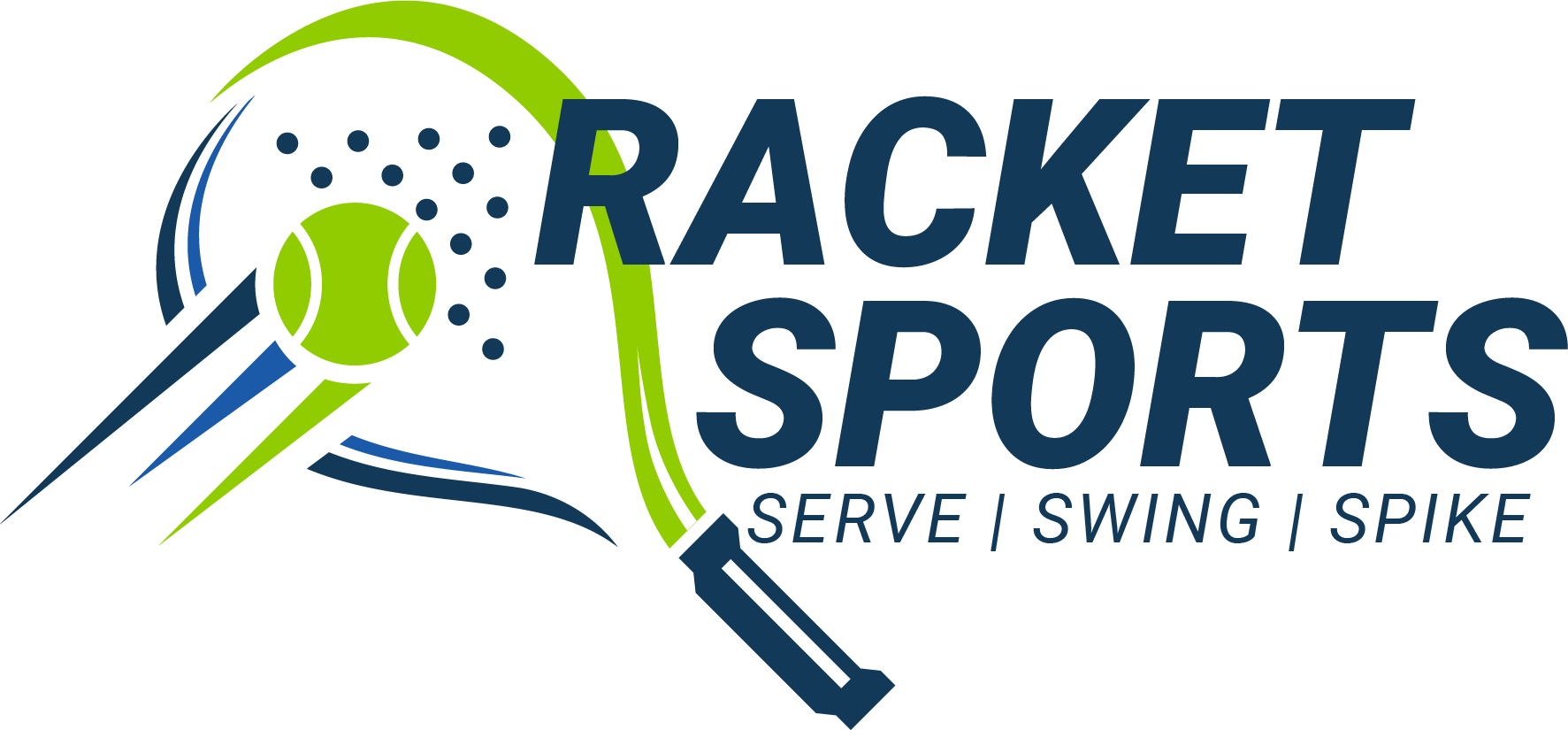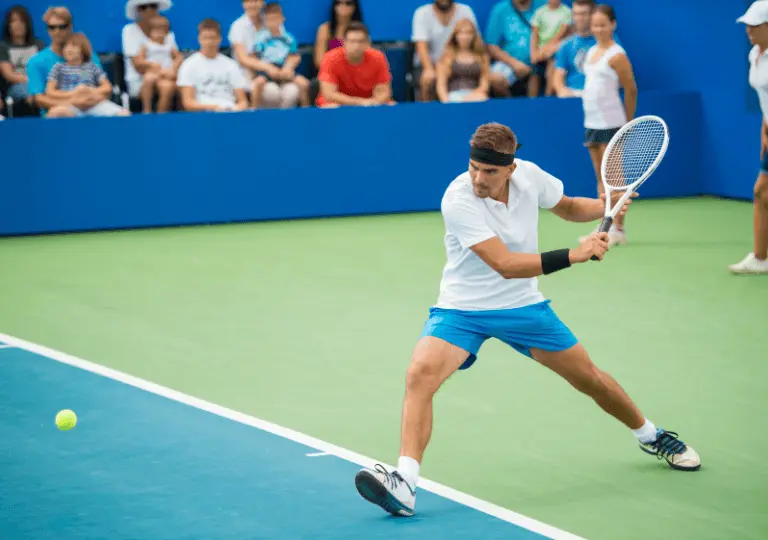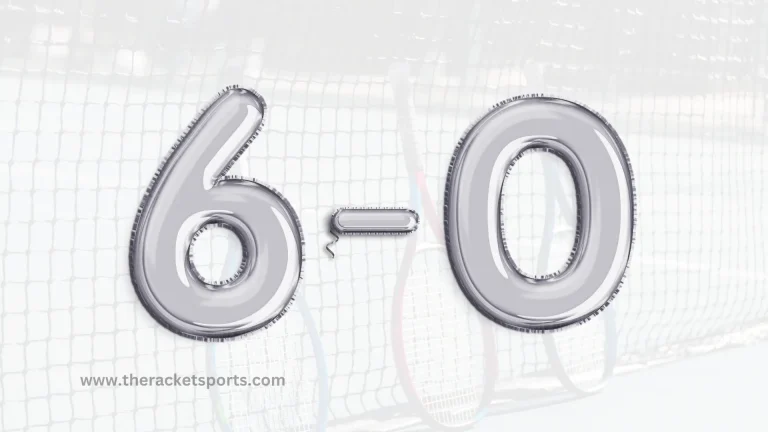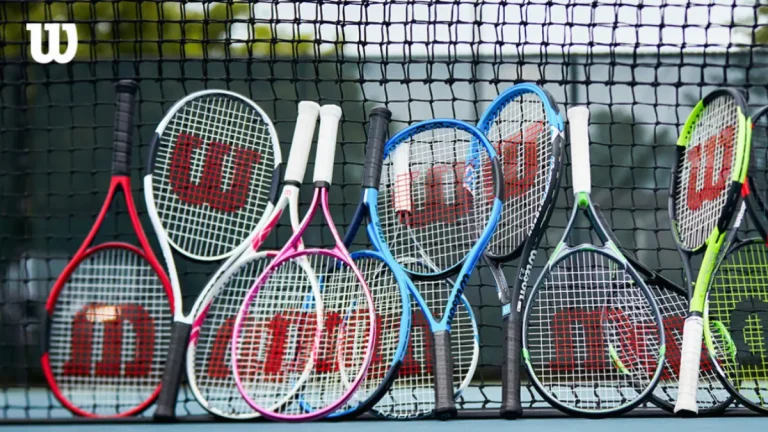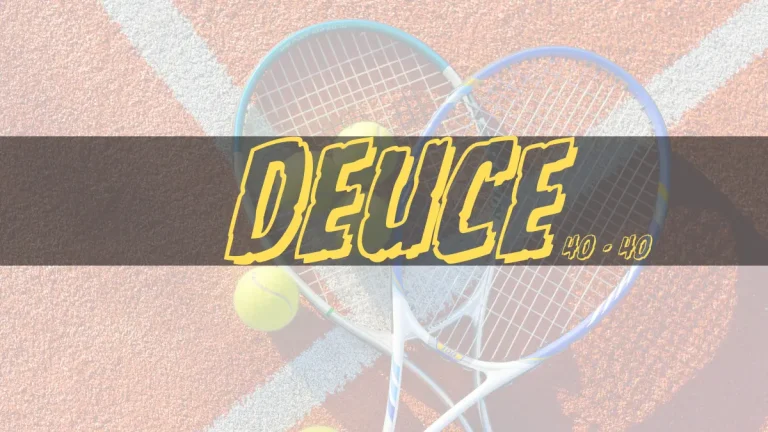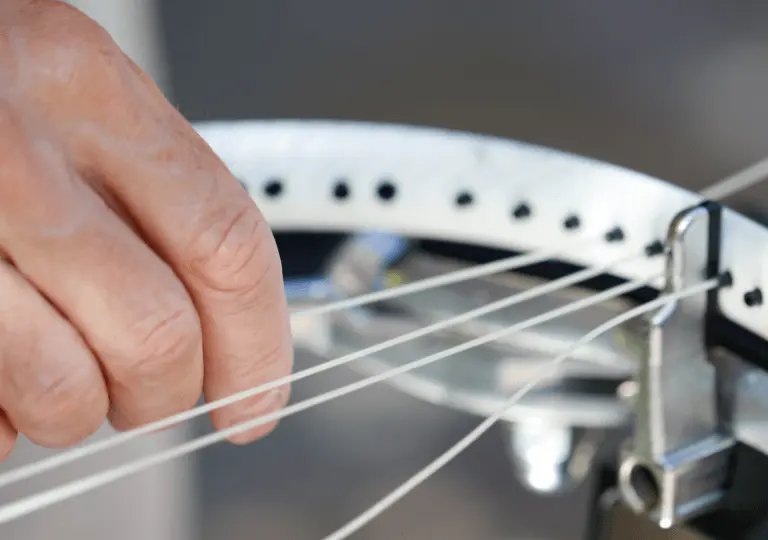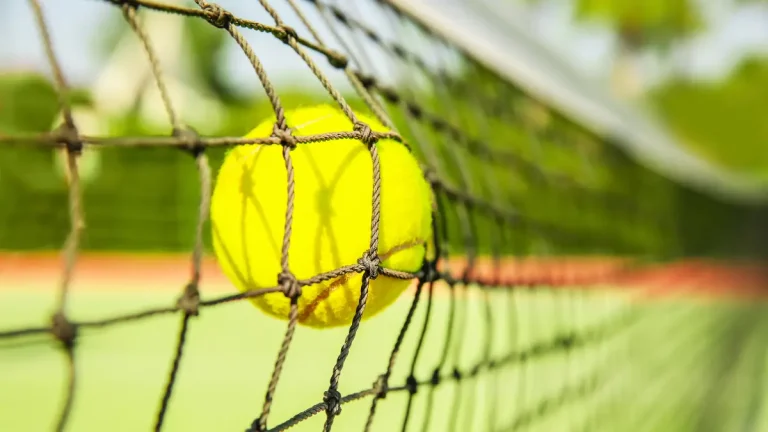Best Tennis Rackets 2025 – Beginners to Professional Choice
Had enough of swinging Rafa Nadal’s Heavy Babolat AeroPro Drive or Novak Djokovic’s Head Speed Pro? Well, you’re not alone. Being a pro tennis player takes tons of practice and a bunch of different rackets.
The best tennis racket for you? There’s no one correct answer. So, how can you find the perfect racket to kickstart your tennis game? Simple–You’ve got to try a few to figure out your style and where you need to improve. But it’s not impossible to narrow down your options. That’s why we’ve compiled a list of the best tennis racquets for you after testing the top brands available.
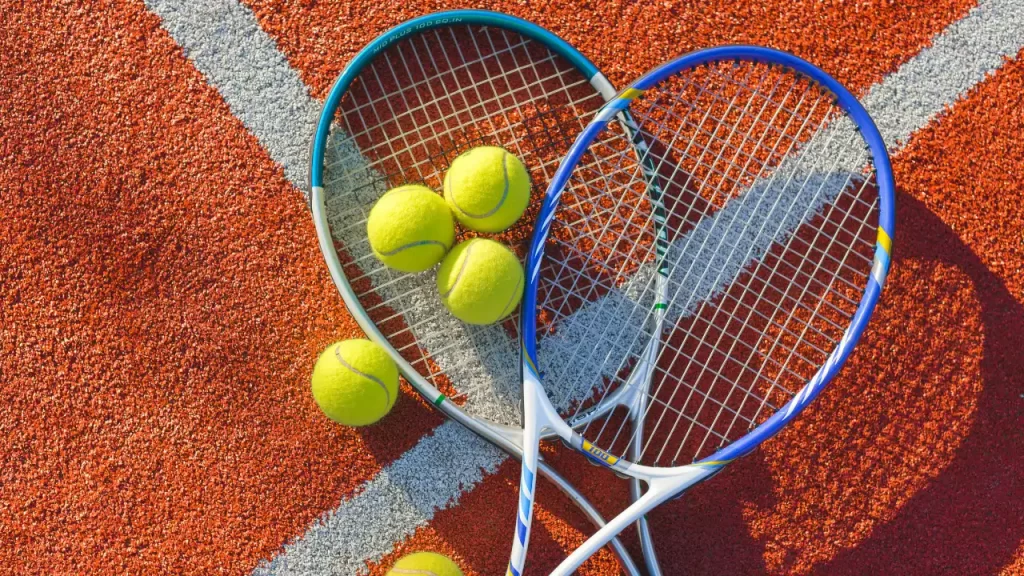
Knowing all the tennis racket types is the number one thing before you start choosing one for you. Find the tennis rackets for spin, control, and power in our top 7 list. For spin, get Yonex VCore 100, and for power, try Wilson Pro Staff 97 v13. Some of these come with recommendations from your favorite tennis pros, and we handpick others. We’ve put them all to the test and even thrown in a buying guide to help you pick the right one. So, let’s start!
Sneak Peak of Best Tennis Rackets 2024
| Tennis Rackets | Head Size(sq. in) | Weight(oz) | Not For | Best for | |
|---|---|---|---|---|---|
| 1. | Wilson Pro Staff 97 v14 | 97 | 11.7 | Not for Beginners | Best Accuracy for Pros |
| 2. | Yonex VCore 100 | 100 | 10.6 | Not Forgiving | Intermediate-level Versatile Performance |
| 3. | Wilson Clash 100 Pro-v2 | 100 | 11.5 | Challenging for Volleys | Comfortable feel and powerful shots |
| 4. | Yonex EZONE 98L | 98 | 10.1 | Too powerful | Great for power and spin |
| 5. | Babolat Pure Drive 107 | 107 | 10.0 | Not for Pros | All-rounder for baseline play |
| 6. | Babolat Pure Strike | 98 | 10.8 | Not for Powerful Volleys | Control and precision |
| 7. | Head Boom MP | 100 | 11.1 | Stability Issues | Advanced player’s budget-friendly pick |
1. Wilson Pro Staff 97 v14 – Best Tennis Racket For Professionals
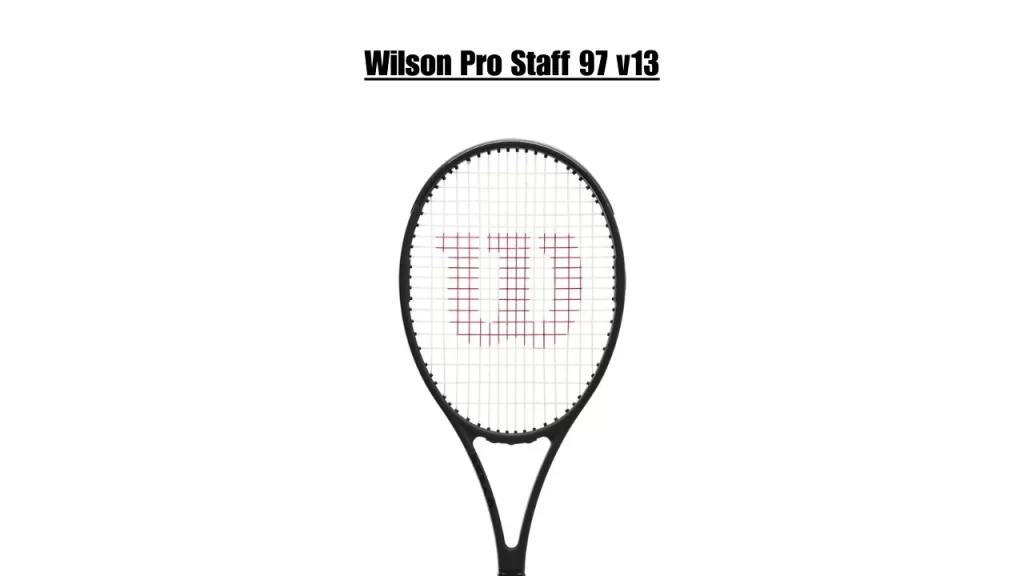
4.6
With a 97-square-inch head and an open 16×19 string pattern, Wilson Pro Staff 97 v14 is designed for precision and control. Despite weighing 11.7 ounces, its 7-point head-light balance is easy to swing.
When hitting groundstrokes, you might notice vibrations, which can benefit professionals. Therefore, the racquet is more sensitive and provides better feedback. However, it might tire out the arms of beginners.
Furthermore, with a new type of construction called “Braid 45,” the racquet feels better and catches the ball more effectively. It uses materials like graphite and Kevlar in a specific way, but you get accurate shots. The string type significantly impacts the tennis racket performance.
Another good thing is that String Mapping Technology tightens the strings in the middle of the racquet. This means you’ll get a better sweet spot! Even with all of these, the racquet still allows you to put a good spin on the ball, thanks to the 16×19 string pattern. Also, the racquet maintains a consistent 21.5mm beam width all around.
Sticking to the classic Pro Staff style, this racquet uses the Perimeter Weighting System. This helps the racquet stay steady and not twist too much when you hit the ball. But remember, this racquet is mainly for control and precision. You’ll have to put in the effort if you want powerful shots.
Also, if you prefer hitting the ball flat instead of using topspin, there might be better choices for you.Tennis players who want an even heavier version can try the Wilson Pro Staff RF97 Autograph. This racket is the one Roger Federer uses, and it’s a bit heavier at 12.6 ounces. But you can still make accurate shots with it, just like the regular Pro Staff.
Final words:
Overall, Wilson has been the leading Tennis industry brand for all the right reasons. It might be better for hitting super-powerful shots, but if you’re a pro, you have the swing to do that. However, if you’re a beginner, check out the Babolat Pure Drive or Wilson Clash 100.
2. Yonex VCore 100 – Best Tennis Racket For Intermediate Players
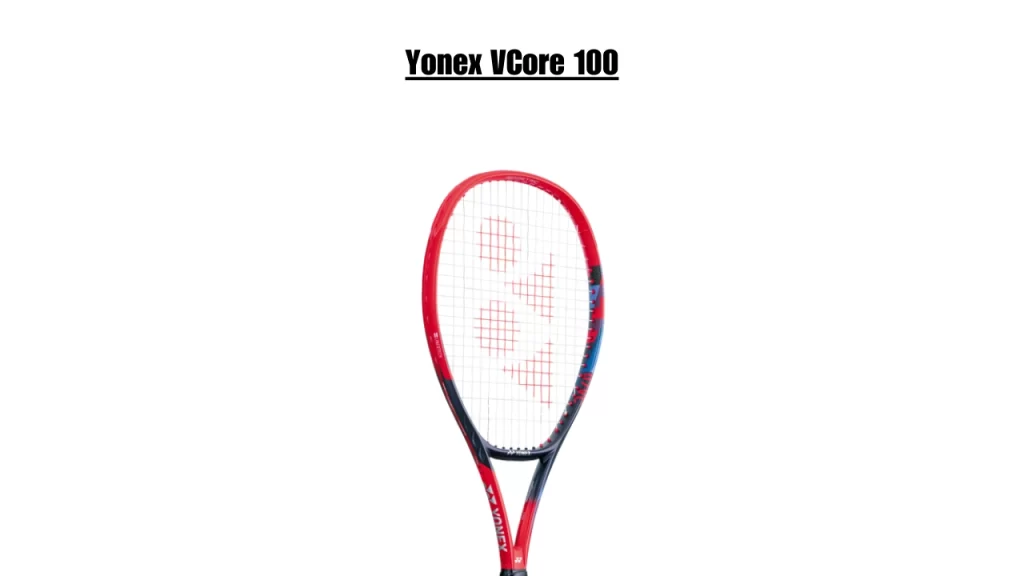
5.0
As intermediate players, you need a forgiving racket that still goes hard on power and spin. The Yonex VCORE 100 is the top pick and has a perfect 100 sq. inches head size. The frame’s increased flexibility and thin tip improve the racquet swing speed.
By picking it up, you can tell it has a maneuverable design with a weight of only 10.6 ounces. The Namd technology and the broadened, rounded tip enhance the sweet spot. This way, players get power without sacrificing control.
Thanks to Yonex’s new dampening technology, you can easily hit shots near the net. But, sometimes, you might lose control, and the ball can shoot off like a slingshot when trying to stop it. For that, adjust the tension of the 16×19 String pattern.
Other features show how it’s perfect for intermediate players, even by looking at technical aspects. The 4 points head-light balance with 320 swing weight is a godsend combination. You can choose Beamwidth from three options: 25.3 mm, 25.3 mm, and 22 mm.
If you’re just starting in tennis, there might be better choices than the VCORE 100 if you want to hit the ball as it’s coming up from the ground near the baseline. However, adjusting your position can compensate for this limitation, and you’ll get more effective returns. But here’s the thing: if you like to serve and quickly rush the net, this racket might not fit you. Even though it has a bigger sweet spot and is light, it’s not for beginner players.
Final words:
The VCORE 100 is a versatile racket suitable for various playing styles. As intermediates, you may experiment with power and control. This racket allows stability while experimenting like no other. It enhances power in serves and forehands while reducing the frustration of off-center shots. Serving with it is easy, allowing for a flat, spin, and well-kicked second serves. We consider this one of the best all-around rackets, offering players power, spin, and versatility.
3. Wilson Clash 100 Pro-v2 – Best Tennis Racket For Arm-Friendly Performance
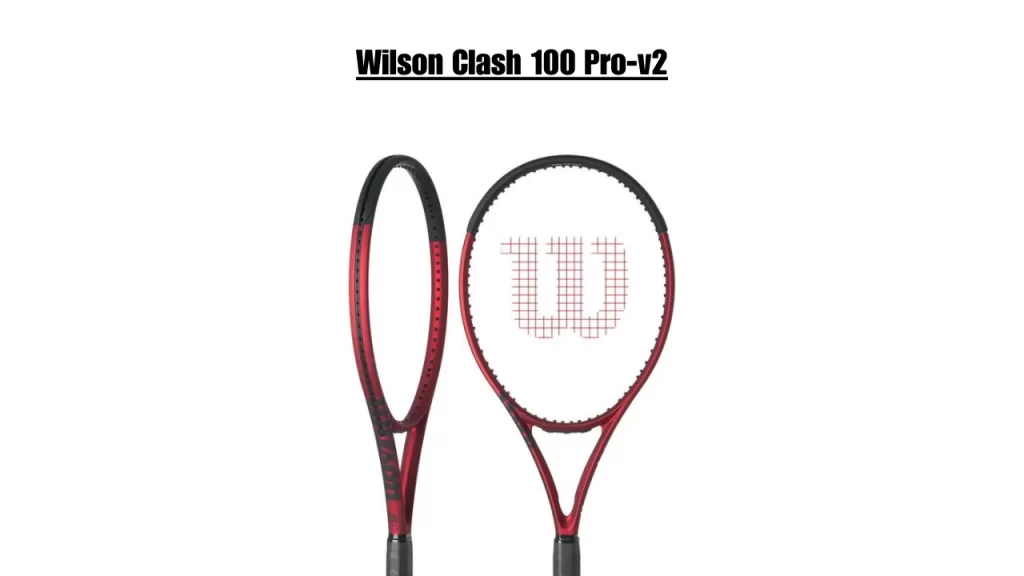
4.4
One thing that we all dream of is a tennis racket that doesn’t tire our arms out. That’s where the Wilson Clash 100 V2 sets itself apart from traditional rackets. With the technologies of FeelFlex and StableSmart, the racket’s flex adjusts according to your playing style.
Thanks to special FORTYFIVE frame tech, the racket bends just right in different ways and makes it easier for you to hit accurately. If you’re new to tennis or not super fast with your swings, the Clash racket will feel nice and comfortable.
It lets you keep the ball on your racket a bit longer, and when you hit it, it’s like using a lightweight racket that’s easy to control. But if you’re a pro, this becomes more solid when you hit the ball hard for those powerful shots.
With the Clash V2, you’ll notice a significant improvement in your groundstrokes. With a weight of 11.5oz, a balance of 9 points HL, and 325 swing weight, it feels crisper and more precise. Such a combination makes it perfect for fast-paced baseline play.
At the net, the open 16×20 string pattern will feel different from rackets made specifically for volleys. Also, we noticed doing a slice shot with the Clash 100 v2 isn’t easy unless you’ve mastered the technique. You can practice for hours to master the technique without tiring your arms out, as that’s the specialty!
Final words:
In summary, the new Wilson Clash 100 V2 is a big improvement over the old version. Even though it’s not like your typical tennis racket, it’s a great choice, especially if you need a practice racket. Say goodbye to sore arms when you choose this.
Also, it not only makes tennis easier but also improves powerful shots. It will take some time to get used to if you’re more familiar with the 16×19 string pattern, but it’s worth it.
4. Yonex EZONE 98L – Best Tennis Racket For Power and Control
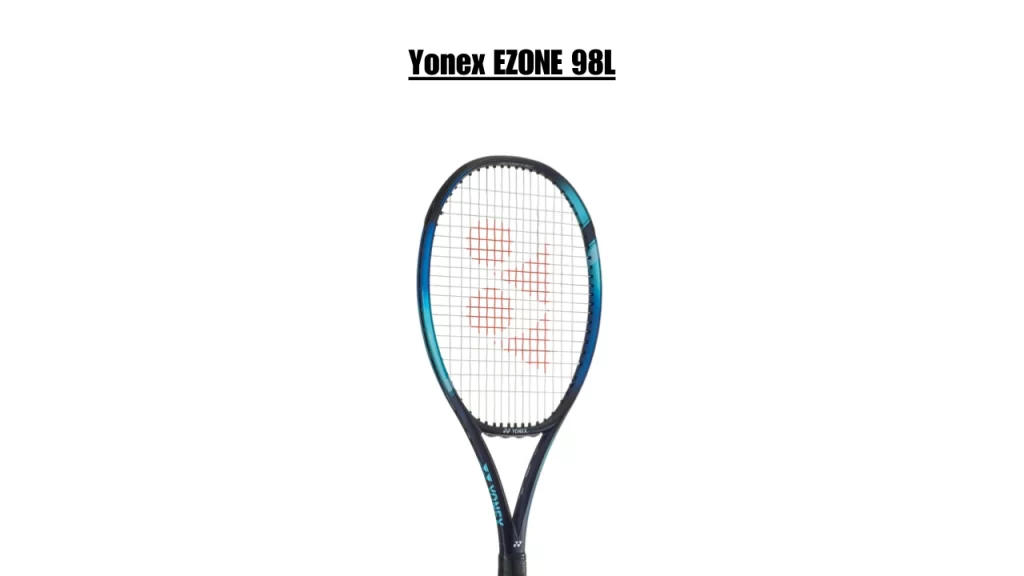
4.6
Looking for power in a beginner-friendly package? Give the Yonex EZONE 98L a try. This tennis racket is suitable for players of all skill levels. Most powerful tennis rackets aren’t stable, yet Ezone 98L takes care of that thanks to flexible graphite called M40X. With a flexible racket that doesn’t wobble too much, you get control even when hitting with power.
At the net, the 98L provides sufficient power to put away shots. We felt like its lightweight design (10.1 oz) makes it easy to position for volleys. However, it may lack a bit of mass for handling high-paced shots. On serves, the racquet delivers easy acceleration for big first serves and effective spin on second serves.
In terms of other specifications, the Ezone 98L has a string pattern of 16×19, a head size of 98 sq. in, and a balance point of 330mm. You can choose from different grip sizes, and the overall design is ideal for all skill levels. Moreover, The Super Cushion Grip minimizes vibrations and protects against shock-induced injuries.
While it might not be as precise as others, it’s still good for hitting shots when you have to move quickly on the court. By adding Yonex’s Isometric technology, it has a bigger sweet spot, so even with a 98-inch head size, you can easily hit the ball. You’ll also hit better off-center shots with Liner Tech grommets. Just make sure to practice, as it may be unstable due to power.
Final words:
In summary, the Yonex Ezone 98L is an excellent choice for intermediate to advanced players. If you’ve already practiced your accuracy in tennis, then you’ll have no complaints with this pick. Its versatile design allows for spin, making it a reliable option for club players. With improved feel, comfort, and performance, this updated model is sure to elevate your game.
5. Babolat Pure Drive 107 – Best Tennis Racket For Beginners
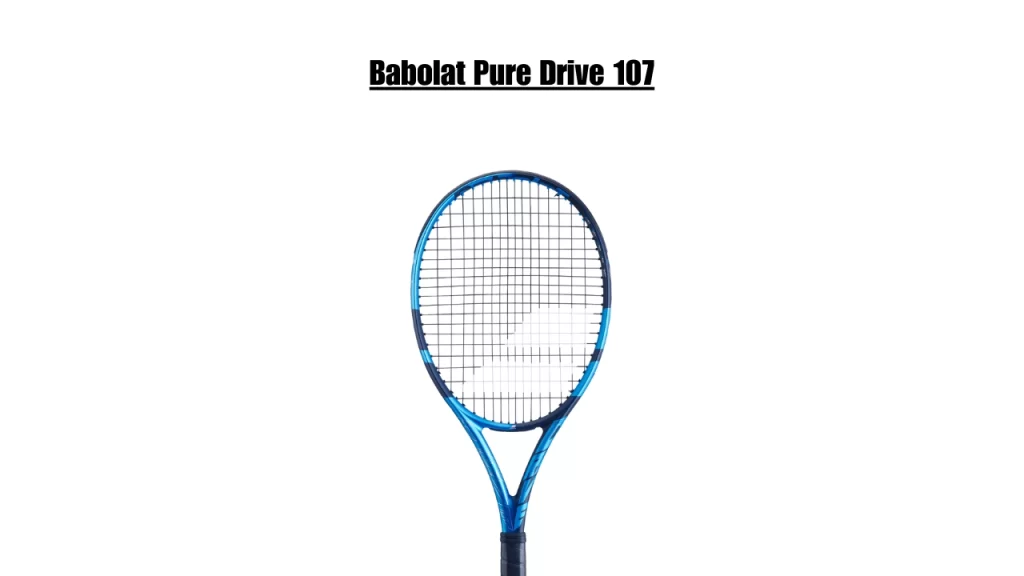
4.8
Beginner tennis players are recommended to avoid spin and powerful tennis rackets, and the Babolat Pure Drive 107 emerges as an exceptional option. When it comes to groundstrokes, the Babolat Pure Drive 107 extends a user-friendly experience. Unlike other rackets, it uses an “elliptic frame” shape that helps you hit the ball hard. It doesn’t erase spin and power from your performance but helps make it easier to hit such shots.
With 107 sq. in head size, you get a generous sweet spot, but volleying with this racket presents a moderate challenge. Though it might take a little time to get used to, you’ll be able to hit powerful shots and handle aggressive volleys effectively with time.
Just know it’s lightweight; only 10 ounces is not for advanced tennis players.
We loved how effortlessly we could serve with this. Its long 27.2 inches length and 16/19 open string pattern give accuracy to improve your serve. You can focus on ball placement and spin without worrying about power. Talking about power, you hear satisfying sounds each time you hit the ball due to SMAC technology.
When it comes to returning serves with the Babolat Pure Drive 107, it works well but could be better. The wide sweet spot boosts your confidence in returning the ball but may lack precision when needed. This racket shines when you prefer an aggressive approach to your returns. For players who aren’t beginners and need a performance similar to Yonex VCore 100, consider this variation of Babolat Pure Drive.
Final words:
In short, the Babolat Pure Drive 107 is a great all-rounder, especially for those who like hanging around the baseline. It’s fantastic for hitting those big groundstrokes and serving with lots of power and spin. But it might not be your best bet if you’re into delicate volleys or tricky shots. However, if you’re new to the game and looking to improve, it’s a good pick.
6. Babolat Pure Strike – Best Tennis Racket For Control
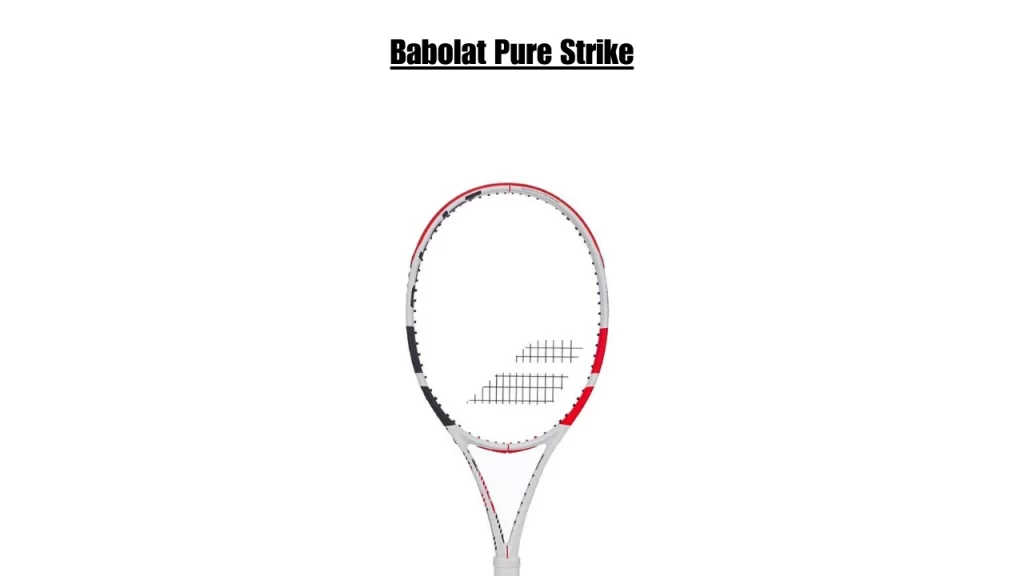
4.5
The Babolat Pure Strike comes with some interesting specifications that make it stand out in terms of control. It has a racket head size of 98 square inches and a weight of 10.8 ounces. These numbers show that this racket offers a nice balance between control and precision. The balance (320 mm) and 16×19 string pattern contribute to its overall stability. Also, it gives a solid and controlled swing with a swing weight of 305.
Do you need a racket that helps you hit strong groundstrokes? This may be the best for most people. That is because it gives you the stability you need. It is for people who prefer control over spin. If you need more spin, try the Babolat Pure Aero used by the famous professional tennis player Carlos Alcaraz.
Surprisingly, this racket works well at the net, too. Thanks to C² Pure Feel and Control Frame technology, you get a soft feel that helps with touch volleys. However, it might take some players a bit of time to get used to the slightly dampened feel of these shots. The generous sweet spot on the racket makes it easier to deliver solid returns.
In conclusion, the Babolat Pure Strike is an excellent tennis racket. It’s perfect for players who prioritize control and want a balance of power, flexibility, and comfort. While it works well all over the court, it truly shines for aggressive baseliners who aim to dominate the game.
Final words:
In short, this racket is perfect for players who like to be in control and want a mix of power, flexibility, and comfort. It’s good for all parts of the tennis court, but especially for players who like to stay at the back and hit the ball hard to win the game.
7. Head Boom MP – Best Tennis Racket For Budget
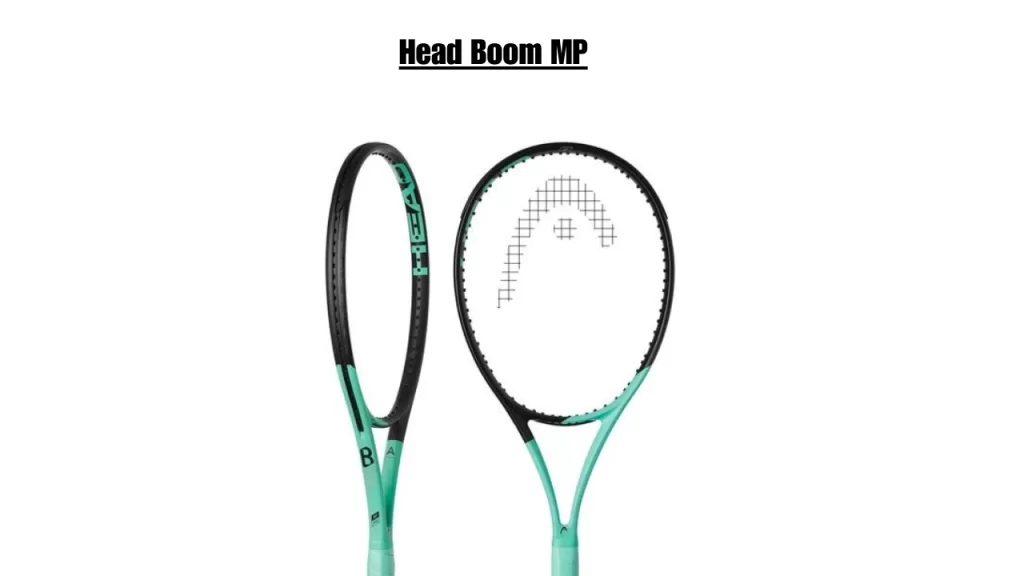
4.8
All the above rackets are quite expensive, but Head has been bringing budget-friendly rackets that cater to the needs of both intermediate and advanced players. With a head size of 100 square inches, a 27-inch length, and a strung weight of 11.1 ounces, Head Boom MP offers good performance.
It’s slightly head-light with a swing weight of 318, so you can add weighted grips if you want to get speed. We found it gentle on the arm, which makes it suitable for practicing all day on the court. In terms of performance, the Head Boom MP is known for its fast-swinging nature. While it doesn’t stand out as the most powerful racket, the generous sweet spot and a forgiving feel make it a power racket.
Many technological features, like the Morph beam for a special shaft. Others are Graphene 360+ for more power and stability and Auxetic tech that makes the frame flexible and great for feeling the ball. Not much can be said about all technologies, but the flexible frame gives you better feedback when you hit the ball.
This makes sending powerful shots all over the court easy, from serves to groundstrokes. Plus, it’s easy to move around with, so you can be quick at the net or hang back on the baseline.
Remember, this tennis racket can be challenging to handle at times. Especially when you’re hitting really strong shots, it may feel unsteady. But you can make it more stable by adding some extra weight. However, it might not be the best choice if you need quick reactions right from the start – it takes practice to get used to it.
Final words:
Simply put, the Head Boom MP racket is a versatile choice that delivers an exciting playing experience. It may take time to get used to. But it’s worth it, given how hard it is to find a racket this advanced at this price. For a faster choice, go for the HEAD Speed Pro, which has the same feel as this. If you’re a woman looking for a lighter alternative, HEAD Ti.S6 may suit you well!
Buying Guide To Choose The Right Tennis Racquet
Know Yourself!
| What to see? | Beginner | Intermediate | Professional |
|---|---|---|---|
| Weight | 260-280g | 275-300g | 295-325g |
| Head Size | 100-110 sq inches (Large) | 98-100 sq inches | 97-100 sq inches (Small) |
| Balance | Head-heavy balance | Neutral or on the lighter side | Head-light balance |
| Power | High | Moderate | Moderate |
| Control | Low | Moderate | High |
| Playing Style | Forgiveness and Easy-to-use | Power, Moderate Accuracy, and Spin | Accuracy, spin, and Self-generated Power |
This table is just an overview, as your playing style will influence your choice of racket. Before you select a racket, know about the parts of a tennis racket. A racket usually consists of many parts, including four main parts head, frame, grip, and shaft. Each part has its own impact on the game.
If you’re into smashing shots with power, go for beginner or intermediate rackets. Experienced players can hit hard with power no matter what racket they use. To learn more, read the guide below to understand the features of tennis rackets.
Features of Tennis Rackets To Consider
- Head Size and Length: What is the importance of Head size and length?
Head size in tennis racket language means the size of the main round part that holds the strings. It’s usually measured in square inches or centimeters. There are three sizes to choose from: standard (27 inches long with a head size of 85-97 square inches), mid-size (a bit longer with a head size of 98-104 square inches), and oversized (up to 29 inches long with a head size over 105 square inches).
Whether you’re a pro or just starting, picking the right head size is important. Check the table above to see which head size is for you.
Weight: What Tennis Racket Weight Should I Use?
Regarding tennis rackets, their weight is like fine-tuning an instrument. The racket’s weight is unstrung and strung, so check both. We don’t want to stereotype, but a tennis racket weighing 290-320g (10.5-11.3 oz) generally works well for men. In comparison, 280-310g (10.2-11 oz) is a good range for women.
The heavier the racket, the more power it brings, so beginners should go for lighter ones. Professionals can go for midweight or heavy ones, but they must find a balance matching their swing speed.
- SwingWeight: How to find the right swing weight?
Swingweight in tennis rackets is vital for balance and power on the court. It reflects how heavy a racket feels when swung, with higher numbers indicating a heavier feel and lower numbers a lighter one. Finding the right swing weight matches your swing speed and racket weight.
Lighter swing weights are for quick, accurate shots, while heavier ones deliver a powerful punch. So, test rackets to see what suits your game based on your body weight and condition.
Grip Size: How Do You know which grip size you need?
Your tennis racket grip size is a big deal because it’s what you use to carry the match(literally). Tennis rackets come in various grip sizes, labeled from 0 to 5. Picking the right size is a must for your comfort and safety. You may lose your grip and get hurt if it’s too small. On the other hand, if it’s too big, it can strain your arm and just won’t feel right.
- String Pattern and Tension: Why are they important, and how to choose?
The string pattern of a tennis racket is all about how the strings are set up. It influences how your racket performs; the main things to think about are spin and control. You can see it in numbers like 16×19, which simply tells you the count of vertical (main) and horizontal (cross) strings. A more open pattern, such as 16×19, allows for extra spin because there’s more space between the strings. However, a denser pattern, like 18×20, provides better control.
Balance: What are the effects of balance on your racket?
The Balance feature in tennis rackets is all about how the weight is spread throughout the racket. When a racket is head-light, it means there’s more weight in the handle. As it’s easier to swing, players can add power to shots. On the other hand, a head-heavy racket has more weight in the head. This can give you extra power but may strain your wrist and increase the risk of injuries like tennis elbow.
Check the table to see which balance point is for you.
Stiffness: What is the right stiffness for you?
With higher racket stiffness, you can deliver more power due to firmness. On the other hand, rackets with lower stiffness ratings are more flexible, offering a balance of comfort and control. Your choice between these two largely depends on your personal preference and the type of tennis string you use. However, if you’ve had issues with your arm, it’s wise to consider a less stiff racket. Also, the stiffness of a tennis racket is rated on a scale from 50 to 85.
Beam Width: What Beam width do you exactly need?
The beam width of a tennis racket is the width of its frame, measured in millimeters at various spots, like the head, shoulder, and frame. A broader beam (24mm or above) provides more power but can be a bit tricky to handle, whereas a narrower beam (22mm or less) offers better control but demands more effort to generate power. An average beam falls in between these extremes.
Conclusion
Ultimately, your choice depends on your unique playing style and skill level. If you are a beginner or playing tennis alone, having a beginner’s tennis racket can significantly improve your style skill level. As you grow in your skill and play on a professional level, upgrading to pro rackets is highly recommended.
It’s a tennis enthusiast’s dream to have an array of options, so choose a tennis racket according to your playing style. Equip yourself with the perfect racket and dominate the court in style. The racket will be with you throughout your tennis journey, so keep trying different ones until you find your match. If you are still confused about the selection, here are our three favorite ones that can improve your game:
- Wilson Pro Staff 97 v14-Best Tennis Racket For Professionals: The Wilson Pro Staff 97 v14 is a top choice for professional tennis players, offering precision and control. While it excels at accuracy and feedback, it’s not ideal for beginners or flat hitters.
- Yonex VCore 100-Best Tennis Racket For Intermediate Players: The Yonex VCore 100 is an excellent choice for intermediate players seeking power and spin with a forgiving design. It’s not best for a serve-and-volley playing style.
- Wilson Clash 100 Pro-v2-Best Tennis Racket For Arm-Friendly Performance: The Wilson Clash 100 V2 stands out for its arm-friendly performance, thanks to FeelFlex and StableSmart technologies. Aside from slice shots, it’s easy to play with, and it adapts to different playing styles.
FAQs
What’s the best tennis racquet for different skill levels?
The best tennis racquet depends on your skill level. Beginners should choose racquets with high power ratings to help generate power. Advanced players, on the other hand, need racquets that offer more control for their powerful swings. Intermediate players can balance power and control based on their preferences.
What string tension should I use for my racquet?
The string tension you choose affects your shots. For more distance, use lower tension strings. If you want better control, go for higher tension. In summary, low tension equals deeper shots, while high tension equals better control at any swing speed.
How do I measure my Grip Size to find the right tennis racket?
To figure out your ideal size, measure from the top of your ring finger to the crease in your palm. It should fall between 4 and 4 ¾ inches. Remember, it’s all about what feels great in your hands, so hold it to determine your perfect fit.
